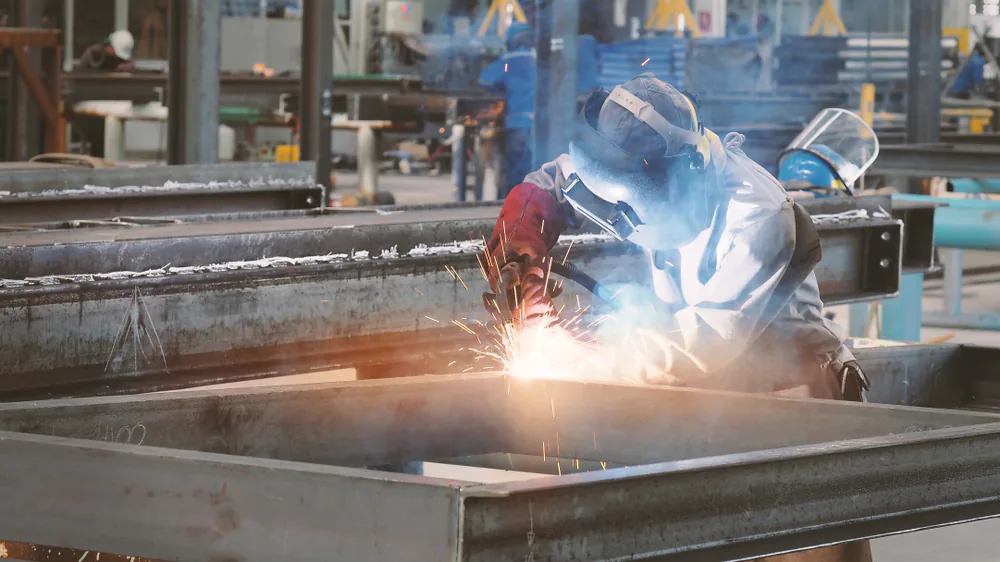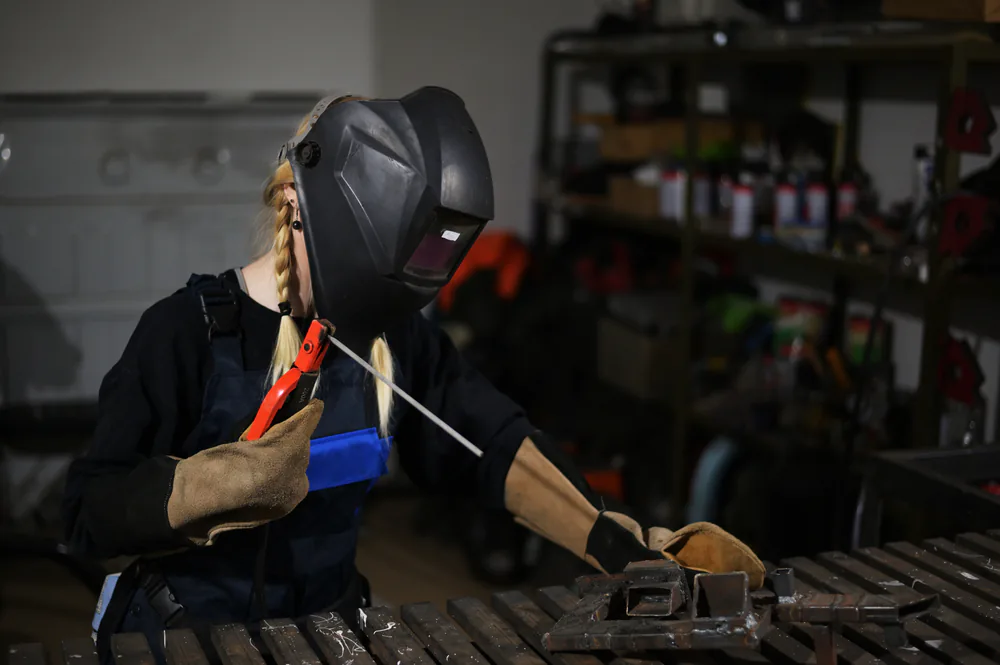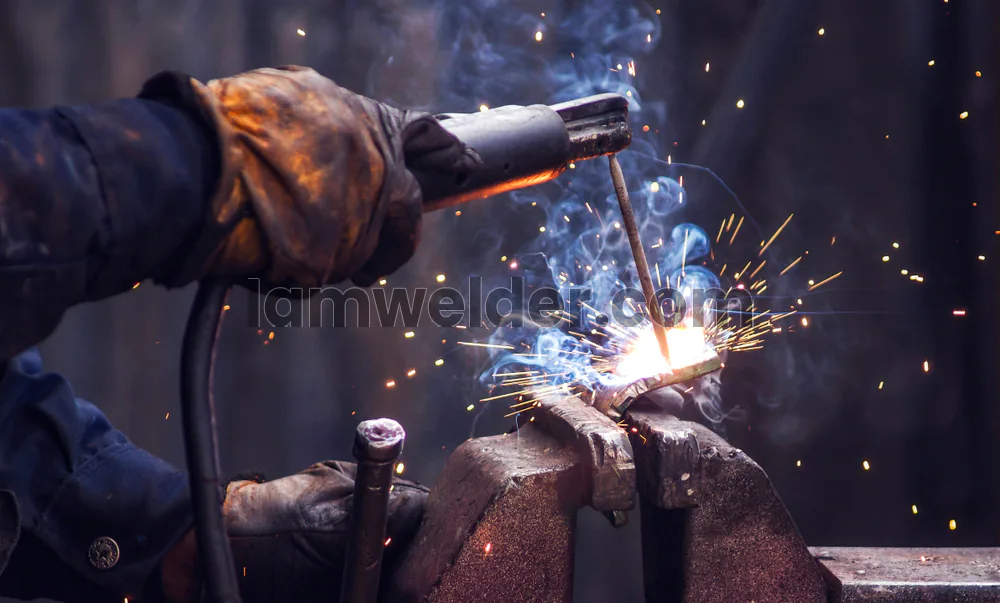Informational
Does Welding Shorten Your Life: Life expectancy of a welder?

Welding is one of the most difficult jobs in the world, and it has serious health consequences. As a result, life expectancy can be disturbed by this profession. In this article, we will look at how welding affects your life span and whether it truly shortens your life expectancy.
Unfortunately, your lifespan does decrease when you weld, especially if you do it for an extended period of time. The average lifespan of a welder is 40 to 50 years. But a lot of factors do come into play. For instance, the kind of welding you do and how many safety measures you adopt while working.
The very next thought that arises is whether or not welding is an occupation that should be pursued given how hazardous it can be. Not really, that’s for sure. If you do it correctly, you won’t have to worry about your health, and you’ll be able to live like a normal person.
I’m aware that welding can cause very serious problems to your health, particularly your lungs, but if you do it correctly, you won’t have to.
Therefore, in the following sections, we are going to examine all of the reasons why welding affects your health and what you can do to prevent those potentially harmful effects.
How Long Do Welders Live?
In spite of all the obvious and possible negative consequences on their health, welders, on average, survive between 40 and 50 years. This is a much lower number than the typical expected lifespan of a healthy normal individual.
According to data provided by Zippia, the following is a plot displaying the average age of welders broken down by both ethnicity and gender:

[table id=12 /]
A regular, healthy individual should expect to live for roughly 72 years on average. That is the average life expectancy throughout the world. On the other side, a nation such as the United States has a life expectancy of around 77 years on average.
In light of this, living for just 40 to 50 years seems unfair. Welders are aware of this fact when they chose their careers and because the risks are so high, a large number of high school students opt not to choose a career in welding.
Here is the chart that breaks down the ages of welder employees.

It’s interesting to note that the typical age of a welder is over 40 years old, which accounts for 53 percent of the whole population.
[table id=13 /]
Why Is Welding Bad For Your Health?
The list of dangerous effects of welding on your health is very huge. Here are a few of the common health problems among welders, according to HSE:
- Irritation to the throat and larger airways in the lungs
- Acute irritant-induced asthma
- Metal fume fever
- Lunge Cancer
- Acute Pneumonia
- Chronic obstructive pulmonary disease (COPD)
- Welder’s lung
- Occupational asthma
- Skin effects
- Neurological effects
- ocular melanoma
- Arc-eye
Allow me to provide you with a concise explanation regarding each of these effects:
1. Irritation to the Throat and Large Lung Airways
Welding fume contains gases and tiny particles that can irritate the throat and chest, causing symptoms such as dryness, coughing, and tightness. The effects are typically quite brief in duration. This could be caused in part by ozone during tungsten inert gas (TIG) welding on aluminum and stainless steel. Excessive inhalation of the gas nitrous oxide, which is produced during most arc welding processes, can be unpleasant. A potential side effect of prolonged ozone exposure is fluid buildup in the lungs.
2. Acute Irritant-Induced Asthma
It is possible for someone to acquire asthma if they are exposed to very high doses of inhaled irritants, although this is a very uncommon occurrence. Previously, medical professionals referred to this illness as reactive airway dysfunction syndrome.
3. Metal Fume Fever
Welding or other hot activities on galvanized metals are often the sources of metal fume fever in humans. High exposure to the gases created by welding mild steel may also induce this illness.
Metal fume fever, in most circumstances, does not cause long-term health concerns. It usually starts a few hours after the start of the exposure and lasts for some time after the end of the exposure.
4. Lung Cancer
Exposure to welding fumes has been linked to an increased risk of lung cancer in a number of studies. According to the International Agency for Research on Cancer (IARC), a welding fume is a Group 1 carcinogenic chemical because it may cause lung cancer and may induce kidney cancer.
HSE asked the Workplace Health Expert Committee for their take on the IARC report, and the committee’s conclusion was in line with that of the IARC study. Since mild steel welding smoke has been linked to cancer, HSE issued a Safety Alert on the topic in February 2019.
5. Acute Pneumonia
Pneumococcal pneumonia is more common among welders because they breathe in the fumes as they work. Welders are at increased risk for a lung infection that may progress to a life-threatening form of pneumonia.
About two welders a year die from pneumonia. Young welders are just as susceptible to this as older workers. Welding fume exposure in the past does not raise the likelihood of developing pneumonia in the present. Welders may protect themselves from contracting pneumonia by being vaccinated. Nevertheless, effective measures to reduce exposure should still be used with vaccination.
6. Chronic Obstructive Pulmonary Disease (COPD)
There is some evidence that exposure to welding fume may induce COPD, but not enough to draw a firm conclusion. Fume may contribute to the rapid loss of pulmonary function often seen in smokers. With COPD well-established, the sufferer has worsening breathlessness, chest tightness, and wheezing. And it might make you tired. Workers might become seriously disabled if the disease worsens.
7. Welder’s Lung
Welder’s lung refers to metal deposition in the lungs induced by welding fume exposure. This kind of pneumoconiosis is typically thought to be innocuous. The welder’s work may not generate any symptoms on its own. However, if both disorders are present, the welder’s lung may exacerbate COPD symptoms.
8. Occupational Asthma
Hexavalent chromium, nickel, and cobalt, which are all found in welding fume, have been linked to occupational asthma. These metals are in the fumes that come off of welding stainless steel, and some welding processes, like MMA, make more of them.
In severe cases of occupational asthma, people may have trouble breathing, wheeze, cough, and feel like their chests are getting tight. Most of the time, symptoms don’t show up until months or even years after the first time a worker is exposed to a respiratory sensitizer at work.
People who work as welders and have occupational asthma may also temporarily lose lung function. This can happen to welders who don’t have asthma as well.
9. Skin Effects
Nickel and chromium that are released during welding can cause allergic contact dermatitis in some people. Welders’ skin is also suspectable to the damage that UV rays can do. The most common skin problem is erythema, which looks like a patch of sunburn.
10. Neurological Effects
Some researchers think that the manganese in mild steel welding smoke causes neurological symptoms that are very similar to those of Parkinson’s disease. Two of the signs and symptoms of this condition are trouble communicating and keeping your balance.
A WEL of 0.05 mg/m3 is good because most of the manganese in the fume will be in the form of very small particles that could get into the deep lung tissue. When particles of manganese fume are inhaled for a long time, they affect the body as a whole. This supports the idea that manganese can get into the body in many different ways, and that any of these ways can lead to neurotoxic effects.
If the right controls aren’t put in place and kept up to date, the WEL for respirable manganese is likely to be surpassed in a number of welding operations. You can use exposure monitoring as one way to figure out if you are safe or not based on the WEL.
11. Ocular Melanoma
This extremely rare form of eye cancer has been connected to welding, specifically the production of UV radiation during welding. When welding, it cannot be emphasized enough how important it is to wear protective eyewear.
12. Arc-Eye
Welder’s radiation may cause severe, sudden damage to the cornea, the transparent, outermost layer of the eye. Within a few hours of welding, the eye usually turns red and uncomfortable. Welding generates radiation that may cause damage to the retina and other components of the eye. This emphasizes the need of using eye protection during welding.
Wrapping it Up
Even though welding can have very serious consequences for a person’s health, particularly if it is done for an extended period of time, those consequences can be mitigated by taking the appropriate precautions and care. At the end of the day, there are negative consequences associated with everything. In this manner do we go about our daily lives.
If I were to summarise the entire study, I would say that if you are considering welding as a career path, you do not need to be concerned about your age being reduced. This is because there is a lot of advanced equipment available these days that helps reduce the negative effects of welding.
Informational
How to Weld If You Have Long Hair? Pro Welder’s Tips

Any welding operation that you perform puts you and anyone else in the area in danger of a number of different things. As a result, it is completely reasonable for you to be concerned about preventing your hair from becoming entangled in any welding equipment and posing a threat to your health. In this article, I will talk about how you can safely weld if you have long hair.
If you want to weld while having long hair, a French braid is the best option for keeping your hair together. This will help you in tying your hair and hold it together behind your neck. The French braid should keep the hair compact and close to your head’s shape, and it also allows you to wear a welding helmet. As a result, you will be able to wear full safety equipment.
When you are dealing with hot weld spatters, having long hair can present a particularly difficult challenge. Therefore, if you are interested in learning more about how you can safely weld with long hair, continue reading the rest of this article, where I will discuss the topic in greater detail and share some helpful hints.
How Your Long Hair Can be an Issue While Welding?
Welding procedures, as I indicated earlier, expose the operator as well as anybody else in the vicinity of the workplace to a wide variety of risks. A project involving welding presents a number of potential dangers and threats; it is important that you be aware of these issues in order to protect not only yourself but also others around you. Especially when dealing with spatters, it is easy for things to go wrong if you have long hair.
Before we look at all of the tips you may weld with long hair, we need to first understand the potential risks you run and everything that might go wrong. Long hair poses a unique set of challenges when it comes to welding. A few are mentioned below:
- Spatters are your hair’s worst enemy.
- UV rays can permanently damage your hair.
- With long hair, grinders can cause serious accidents.
Let’s look at these problems one by one:
1. Take Spatters Seriously
The spatter, sparks, and heat generated by the arc provides the greatest challenge throughout the welding process since they may travel up to 35 feet and enter any nearby place. You will want to provide enough protection for your long hair if you are going to be in an atmosphere like this.
Not just your hair, but everything else that might catch fire should be kept at least 35 feet away from the welding location. In addition, a fire extinguisher should never be far away. In the event that a fire breaks out.
2. UV Rays Can Damage Your Hair Permanently
Molten metals, welding arcs, and ultraviolet radiation will be present in the work environment while welding is being done. The interaction of all these factors puts you at an increased risk of serious burns. The actual welding arc may reach temperatures of up to 10,000 degrees Fahrenheit, making it one of the hottest processes possible.
And believe me when I say that you do not want that welding arc to get anywhere near your hair. Your hair will suffer a significant amount of damage as a result, and it is possible that it could even be burned.
3. Grinder Can Give You Nightmares
The usage of grinders is another factor that may create issues for your lengthy hair. Using grinders and welding go hand in hand when working with metals. Therefore, if you are a welder, you will most likely make extensive use of the grinder. And grinders are really your worst enemy when it comes to your long hair.
When you’re working, you can find yourself crouching over a grinder, which can cause serious accidents if you don’t protect your hair properly.
Tips from a Pro Welder to Protect Your Long Hair When Welding
Now you know what the most obvious dangers that you have when welding with long hair. The next step is to tell you how you can keep yourself safe from those dangers.
Here are a few of the tips that you can consider:
- Braid your hair while welding
- Put your hair in a tight knot behind your neck
- Consider buying a welding cap
- You can use a bandana too if you are a bandana lover
Let’s discuss these tips one by one:

1. Braiding is the Best Option You Have
Welding hoods, helmets, or shields will provide the optimum amount of protection from any sparks, heat, UV rays, flash burns, or infrared light that may be present. They will protect not only your face and neck but also your eyes and hair. As a result, I feel that acquiring one is the best approach to protecting oneself.
Welding hoods are often made of cotton or leather and are rather light in weight and can go easily along with helmets. Make sure that whichever helmet you decide to purchase, is not too heavy and that it is comfortable to wear. It must also include a spatter barrier, the ability to be modified, a sensor bar, and the availability of replacement components.
2. You Can Simply Put Your Hair in a Tigh Knot
The most conventional and easiest technique for a welder operator to keep their long hair out of their face is to pull it back into a tight bun. Wrap an elastic band over your buns and secure them in place to prevent them from falling on your face.
If there are any unruly hairs, just use bobby pins to push them up and you should be OK. Anything that prevents your hair from falling on your face will suffice.
3. Consider Buying a Welding Cap
A welding cap is a good option if you want something that is both lightweight and comfortable. It must adequately shield your head from any hot metal, sparks, or splatters that may be present.
Not only they are effective in protecting your hair, but they are also made completely of cotton, making them incredibly breathable and also preventing sweat from pouring down your eyebrows while working.
4. Bandana is Another Option That You Can Use
Braids are not easy to create for everyone, and they may even be difficult to perform on a regular basis. If you don’t know how to braid my easiest suggestion would be to put a bandana over your head and tuck all of your hair within.
When welding, sparks will fly everywhere, and this will keep you safe. Make use of bobby pins or a bun to tuck in all of the ends. Bandanas aren’t my first choice for headgear. But it works. It’s a good option to have in case you don’t know how to braid your hair.
Few Other Safety Measures That You Need to Take
In addition to your hair, there are a few other parts of your body that need your attention. Some of these essential measures for ensuring your safety are listed below:
- Protect your eyes at all cost
- Always keep a fire extinguisher in your shop
- Wear protective clothing
- Make habit of using respirators
- Beware of leakages in your welding system
- Keep your welding space clean
Let’s discuss them one by one:
1. Protect your eyes at all cost
Be sure to always wear safety glasses in your workplace to protect your eyes from flying debris, which is often composed of metal. If you routinely do welding tasks, you will be exposed to a significant amount of flying debris.
You should make it a routine to put them on as soon as you come in the door; this will ensure that you are protected at all times.
2. Always keep a fire extinguisher in your shop
You shouldn’t be shocked if anything catches fire at some time during a welding operation because of all of the intense heat and sparks that are produced throughout the process. Because fires are a very real risk, you should always have an extinguisher on hand in case one breaks out.
3. Wear protective clothing
If you’ve ever imagined yourself beginning your first welding project in a pair of shorts, an old t-shirt, and a pair of flip-flops, you should rethink that idea. Wearing the necessary protective clothing at all times when welding is required if you wish to prevent injuries to your body, notably burns, that may be caused by the process.
4. Make habit of using respirators
You should always wear a respirator if you are going to be dealing with metals or any other materials that have the potential to emit harmful vapors.
Welding or cutting certain materials may produce a welding plume, which is a combination of hazardous gases, fumes, and smoke. This is not the type of thing you want to breathe in if you want to keep your lungs healthy and prevent respiratory issues.
5. Beware of leakages in your welding system
There is a good chance that you have pressurized containers in your welding shop that hold liquids or gases. Take extra precautions to check that none of those containers or the items that you are attaching to them have any leaks in them.
See my other article to know more about leakages and how to detect them.
6. Maintain your equipment
If you want to establish the safest possible working environment for your welding projects, you need to give your equipment a lot of TLC and make sure it’s in good operating order at all times. If your welding equipment and tools are in disrepair, an accident is almost waiting to happen every time you use them. However, the vast majority of incidents of this kind are avoidable if proper care is taken with the equipment.
Wrapping it Up
When it comes to welding, safety is the most important thing to keep in mind at all times. Because because welding involves a significant amount of fire and spatters, it is essential that you take a significant amount of precaution to protect your hair. I really hope that you’ll be able to keep your hair under control while welding thanks to the advice that’s been provided in this article.
Weld Types
Different Welding Methods: Applications of Each Method

Welding is joining two pieces of metal together by melting and cooling them until they become one piece. Welding processes include:
- Oxyacetylene welding
- Shielded metal arc welding (Stick)
- Gas tungsten arc welding (TIG)
- Gas metal arc welding (MIG)
- Flux-cored arc welding
- Torch or oxyfuel brazing
Some methods employ both heat and pressure, while others employ only heat. Welding is commonly used to construct automobiles, airplanes, and buildings. Other metal-cutting methods, such as oxy-acetylene and plasma arc cutting, use heat or electricity to cut through metal.
1. Oxyacetylene welding
Oxyacetylene welding (OAW) is a method of joining two pieces of metal using heat generated by the combustion of oxygen and acetylene gas.
Torch brazing (TB) is similar, but the metal is not completely melted. Instead, a special alloy is melted and used to join the two metal pieces.
Oxyfuel gas cutting (OFC) is a method of cutting metal that uses the same tools and gases as OAW and TB.
To generate heat and bond the metal, all of these methods employ a torch and special gases. They are frequently used on small or thin metal pieces.
Applications:
- Welding and brazing thin or small pieces of metal
- Welding and brazing dissimilar metals
- Cutting and piercing metal
Situations to Avoid:
- Welding thick or heavy sections of metal
- Welding high alloy or stainless steel
- Welding in high wind or outdoor conditions (due to the open flame)
- Welding in confined spaces (due to the production of harmful gases)
2. Shielded metal arc welding (Stick)
Shielded metal arc welding, or SMAW, is a way of welding metal together using an electrode that is coated with a special kind of flux.
The electrode melts and becomes a part of the welded metal. To do SMAW welding, you need a transformer, two welding cables, a work clamp, and an electrode holder.
There are many different types of electrodes you can use for SMAW welding, so you can choose the one that is best for your project. With SMAW welding, you can join different types and thicknesses of metal using the same machine.
Applications:
- Welding thick or heavy sections of metal
- Welding in outdoor conditions
- Welding in dirty or contaminated environments
- Welding on dirty or painted surfaces
Situations to Avoid:
- Welding thin or small pieces of metal (more suited for TIG welding)
- Welding high alloy or stainless steel (can affect the quality of the weld)
- Welding in confined spaces (due to the production of harmful gases)
- Welding in the presence of high winds (due to the electric arc)
3. Gas tungsten arc welding
GTAW, or gas tungsten arc welding, is a method of joining metal using a tungsten electrode. The tungsten electrode generates an electric arc, which melts the metal being welded as well as the end of the filler metal, which is manually applied.
Shielding gas is emitted from the welding gun to protect the molten weld metal from dirt and other contaminants. A foot or thumb switch can be added to the GTAW equipment to help the welder better control the welding.
GTAW welding produces very clean, high-quality welds, but it is slower and requires more skill than other welding methods. It is particularly useful for joining metal alloys that can only be joined with GTAW.
Applications:
- Welding thin or small pieces of metal
- Welding high alloy or stainless steel
- Welding in outdoor conditions (with proper shielding gas)
- Welding materials with high levels of contaminants or impurities
- Welding in high-precision environments
Situations to Avoid:
- Welding thick or heavy sections of metal (more suited for MIG welding)
- Welding in high production environments (slower process)
- Welding in confined spaces (due to the production of harmful gases)
- Welding in the presence of high winds (due to the electric arc)
4. Gas metal arc welding (MIG)
Mig welding is a type of arc welding that uses a continuously supplied wire electrode and gas to weld metal together.
It is becoming more popular because it is easier to learn than other types of welding, like stick and tig welding, and it is faster because you don’t have to stop and change the electrode as often.
Mig welding also creates less slag and spatter, which makes it more enjoyable to use and easier to clean up.
However, MIG welding equipment is more expensive and the MIG gun, which is the portable part of the equipment, can be difficult to use in small spaces. Mig welding also requires a shielding gas to work, so it is not as good for outdoor use.
Applications:
- Welding thick or heavy sections of metal
- Welding high alloy or stainless steel
- Welding in high-production environments
- Welding in outdoor conditions (with proper shielding gas)
Situations to Avoid:
- Welding thin or small pieces of metal (more suited for TIG welding)
- Welding in confined spaces (due to the production of harmful gases)
- Welding in the presence of high winds (due to the electric arc)
- Welding materials with high levels of contaminants or impurities (can affect the quality of the weld)
5. Flux-cored arc welding
Flux-cored arc welding, or FCAW, is a method of joining metal using a special type of electrode wire known as a flux core wire.
The wire is fed from a spool continuously through the welding equipment and out of the gun. The welding current flows through the equipment, melting the wire and the base metal.
Some flux core wires generate their own shielding gas as they melt, while others require the use of additional shielding gas. As the wire melts, it produces a gaseous cloud that shields the weld surface and removes impurities from the molten metal.
After the weld is completed, a layer of slag must be removed from the weld’s top. Despite this additional step, FCAW is a popular welding technique because it produces high-quality welds quickly and is very versatile.
FCAW equipment is similar to that used in gas metal arc welding (GMAW), and both methods are semiautomatic, which means that the wire is fed automatically but the welder moves the gun manually. Welding supply stores and other retailers stock FCAW equipment and filler metals.
Applications:
- Welding thick or heavy sections of metal
- Welding in outdoor conditions (with proper shielding gas)
- Welding in high-production environments
- Welding in dirty or contaminated environments
Situations to Avoid:
- Welding thin or small pieces of metal (more suited for TIG welding)
- Welding high alloy or stainless steel (can affect the quality of the weld)
- Welding in confined spaces (due to the production of harmful gases)
- Welding in the presence of high winds (due to the electric arc)
Comparison Table:
| Welding Process | Applications | Situations to Avoid |
|---|---|---|
| Oxyacetylene welding | Welding and brazing thin or small pieces of metal; welding and brazing dissimilar metals; cutting and piercing metal | Welding thick or heavy sections of metal; welding high alloy or stainless steel; welding in high wind or outdoor conditions; welding in confined spaces |
| Shielded metal arc welding (Stick) | Welding thick or heavy sections of metal; welding in outdoor conditions; welding in dirty or contaminated environments; welding on dirty or painted surfaces | Welding thin or small pieces of metal; welding high alloy or stainless steel; welding in confined spaces; welding in the presence of high winds |
| Gas tungsten arc welding (TIG) | Welding thin or small pieces of metal; welding high alloy or stainless steel; welding in outdoor conditions (with proper shielding gas); welding materials with high levels of contaminants or impurities; welding in high-precision environments | Welding thick or heavy sections of metal; welding in high production environments; welding in confined spaces; welding in the presence of high winds |
| Gas metal arc welding (MIG) | Welding thick or heavy sections of metal; welding in high production environments; welding in outdoor conditions; welding on dirty or painted surfaces | Welding thin or small pieces of metal; welding high alloy or stainless steel; welding in confined spaces; welding in the presence of high winds |
| Flux-cored arc welding | Welding thick or heavy sections of metal; welding in high production environments; welding in outdoor conditions; welding on dirty or painted surfaces | Welding thin or small pieces of metal; welding high alloy or stainless steel; welding in confined spaces; welding in the presence of high winds |














